To some, street art may still seem unusual – even uncomfortable – but endeavours like Perth’s 140 project are spearheading the idea that public works are so much more than just graffiti.
A set of huge lips on a kaleidoscopic face pouts towards Northbridge from the corner of William and Wellington streets. The giant wall mural by artists Beastman and Vans the Omega features vibrant blues, greens, yellows and browns in a geometric-yet-fluid medley of four faces, and is one of a growing number of site-specific, large-scale works by local, national and international artists that are transforming 140 William Street into a cultural hub.
Most shopping centres in Perth have been around since the 60s, and, says Kristi Dempster, marketing manager at 140, did nothing to improve the identity of our city.
"I think why CBD retail has failed is because it has tried to really emulate what suburban centres are doing from a shopping point of view, and the city isn't about that," Kristi says. "I think property owners in the city need to start to understand that they need to deliver something different – CBDs are usually about culture, and I think art murals really contribute to that."
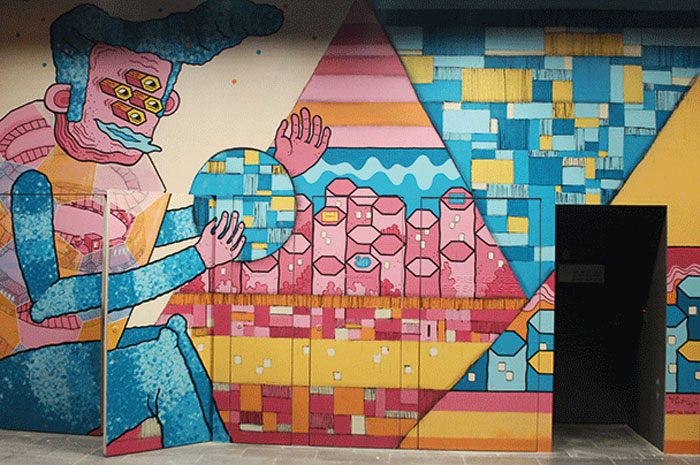
Part of a mural by Benjamin Johnson and Kyle Hughes-Odgers. BELOW Beastman and Vans the Omega at work.
Since its beginnings in 2010, we've slowly seen the 140 retail space turn into
a labyrinth of urban and contemporary art, its laneways covered in paint, sculpture, Perspex and honeycomb structures.
"We identified a real niche in the market and an opportunity to do something different with arts and culture," Kristi says, on how the CBUS Property Group project came about. "We looked to really connect the cultural precinct in Northbridge and William Street, and use the property as a common loop to inject that culture back into the CBD and on Murray Street Mall."
CBUS developed a jam-packed arts program that has seen some of the world's best artists and creatives – from Perth's jewellery king Alister Yiap, to US geometric artist Matt W. Moore – do just that.

"The works are a way for the people of Perth to interact with a physical space and appreciate it," says Kristi. "Twelve artists painted murals on shopfronts while we were building, and people walking to work were smiling and taking pictures and interacting."
Kristi says art in and around a city really contributes to its urban fabric.
"It always evokes some kind of emotional response – it might be something really simple, and it's not necessarily tangible or measurable, but it definitely adds to the public space and public realm," she says. "It creates a uniqueness about a place or a destination or a precinct in itself, and I think it's really interesting to look at how people respond to it, especially in Perth where it's so sterile and it's all the same."
Anya Brock, who installed four giant budgies on the facade next to the Aviary during the building's renovation, agrees.
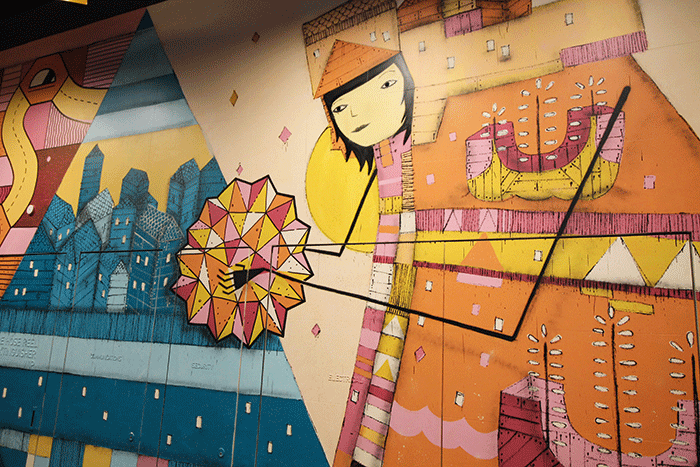
"I don't understand why people build such boring buildings all the time," she says. "I don't really get it. It just seems crazy when the sky's the limit – you can do whatever, yet people just build boring buildings over and over again."
The artist says the project has done a lot to help shape the reputation and credibility of street artists and muralists alike.
"Street art in the city of Melbourne has been recognised for a while, but even so, a lot of people still confuse street art with graffiti," Anya says. "I guess a lot of mainstream people in society don't really understand what street art is. To bring that type of art into a more everyday corporate world and pair it with a commercial precinct like 140, if it's going to give artists a little bit more recognition in the media and in mainstream society, and get artists paid, I reckon it's a great thing."
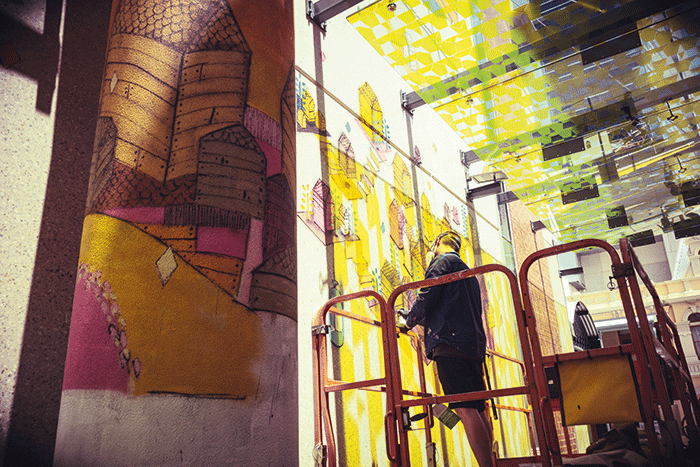
Kyle Hughes-Odgers adds to his wall art. ABOVE Kyle's pensive character, part of his collaborative mural with Benjamin Johnson.
Although street art in Perth has become more widespread, Kristi says there are still generations of people who perceive it as graffiti.
"Graffiti art and street art have been quite controversial for some time, and not always been valued because they've been perceived as defacing property," she says. "But when you look at most iconic laneways around the world, whether you're looking at London, Paris or Madrid, a lot of that is graffiti art."
Kristi believes the bottom line is that people don't understand the value behind public art, what it contributes to the city's urban fabric, or to people who are using the building and walking past it.
"I think the younger generation appreciates it and can understand the value of it, but I think other generations, particularly the older generations, are still confused about it."
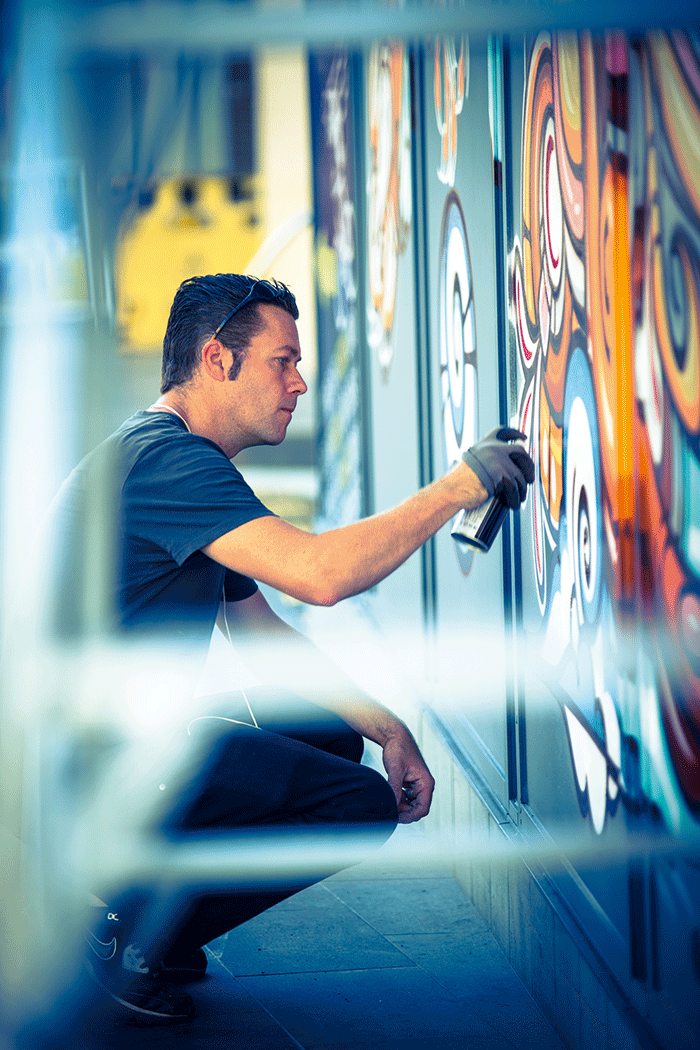
Artist Phibs gets to work with a spray can.
Despite the push by projects such as 140, and initiatives like FORM's PUBLIC: Art in the City (FORM was the first to put a multitude of large public murals up around Perth), Kristi still says property owners don't immediately warm to the idea.
"It will take a while for them to understand that if you put a mural up, in three years' time if you don't like it, you can change it," she says. "They feel like it's a decision that's so concrete, rather than allowing the property to transform and the space to transform, and I think that's the reason it hasn't been adopted."
The 140 project is helping to change that, influencing the attitudes the people of Perth have towards street art by using differing art styles and media in its build.
"We didn't want the art that had been curated to be pretentious or hard for people to understand," Kristi says. "We wanted children to your grandparents to be able to come into the precinct and to not have to necessarily understand it, but to appreciate it."
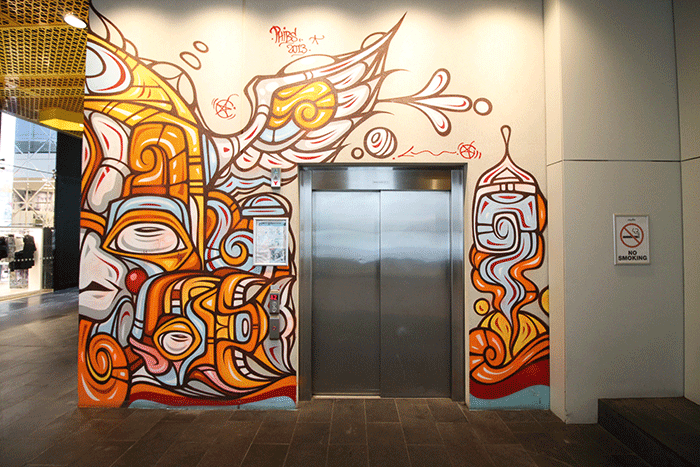
With murals by street artists, sculptures by jewellery designers, and hanging jewels by installation artists, 140 presents a mixed bag. This was essential for a broader reach, the developers realising that not everyone had to like each piece, just as long as the works roused conversation and became part of people's dialogue about the CBD.
And it has created a buzz – not just with the public but with investors and property owners, too.
"140 has been a real challenger and has forced other developers and other owners to really step back and take a look at what we're doing here," Kristi says. "We've had a lot of our competitors actually seeming to adopt our strategy, which I find is hilarious because it was the ugly duckling for a while."
Unfortunately, Kristi says that with property it's all about return on investment, so it's hard for developers to understand the value of art in building design.

US creative Matt W Moore's geometric ceiling at 140.
"It's not a tangible outcome, incorporating art into your development – it doesn't necessarily increase the value," she says. "It may over time, if it becomes quite iconic in a way, or people probably will come to value certain elements of the property, but it is not guaranteed success."
It was a gamble 140 was willing to take, and if its social media presence is anything to go by, the project is definitely turning heads. "On Instagram, I think we're pushing about 10,000 followers, and we've never even launched to market," Kristi says. "People have responded to what we've done and we've received local, national and international exposure – The New York Times has even picked up images of our art."
With attention like that, it's no wonder the precinct has become the figurehead
for Perth's emerging urban landscape. Just look around the next time you're
there – someone is bound to be taking a photo of one of the murals, gawking up at the geometric ceiling covering the Forrest Chase entrance, or arguing about whether they love or hate the unashamed display of colour in this part of town.